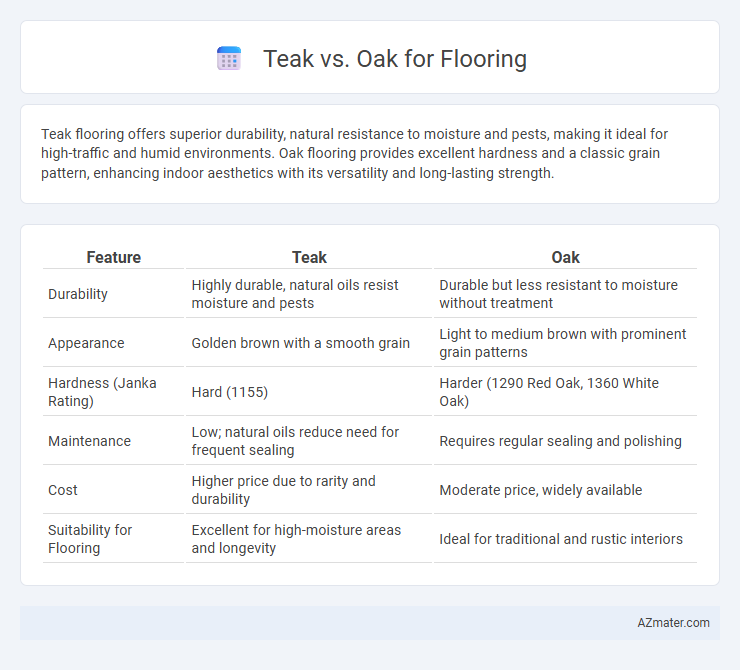Teak flooring offers superior durability, natural resistance to moisture and pests, making it ideal for high-traffic and humid environments. Oak flooring provides excellent hardness and a classic grain pattern, enhancing indoor aesthetics with its versatility and long-lasting strength.
Table of Comparison
| Feature | Teak | Oak |
|---|---|---|
| Durability | Highly durable, natural oils resist moisture and pests | Durable but less resistant to moisture without treatment |
| Appearance | Golden brown with a smooth grain | Light to medium brown with prominent grain patterns |
| Hardness (Janka Rating) | Hard (1155) | Harder (1290 Red Oak, 1360 White Oak) |
| Maintenance | Low; natural oils reduce need for frequent sealing | Requires regular sealing and polishing |
| Cost | Higher price due to rarity and durability | Moderate price, widely available |
| Suitability for Flooring | Excellent for high-moisture areas and longevity | Ideal for traditional and rustic interiors |
Introduction to Teak and Oak Flooring
Teak flooring offers exceptional durability and natural resistance to moisture and insects, making it ideal for high-traffic and humid environments. Oak flooring, known for its strength and classic grain patterns, provides a timeless aesthetic with high wear resistance suitable for various interior styles. Both hardwoods present sustainable flooring solutions, but teak's natural oils deliver superior longevity compared to the more porous oak.
Durability Comparison: Teak vs Oak
Teak flooring offers superior durability due to its high natural oil content, making it highly resistant to moisture, decay, and insect damage, ideal for high-traffic and humid environments. Oak flooring, especially white oak, provides strong wear resistance and hardness with excellent shock absorption, but it is more susceptible to moisture-related issues and requires proper sealing. Both woods are durable choices, yet teak's natural oils give it a distinct advantage in longevity and low maintenance compared to oak.
Appearance and Grain Patterns
Teak flooring showcases a rich golden-brown hue with natural oils that provide a smooth, lustrous finish resistant to moisture and pests, making it ideal for humid environments. Oak flooring presents a lighter, warm beige to reddish-brown color with prominent, intricate grain patterns featuring swirls and knots, offering a classic, timeless aesthetic. While teak's grain is generally straight and uniform, oak's bold and varied grain patterns deliver strong visual character and versatility in interior design styles.
Resistance to Moisture and Termites
Teak flooring offers superior resistance to moisture due to its natural oils, making it highly durable in humid or wet environments and less prone to warping compared to oak. Oak, while strong, is more susceptible to moisture damage and requires proper sealing to prevent swelling and mold growth. Both woods provide termite resistance, but teak's dense grain and natural oils give it a distinct advantage in repelling termites over oak.
Hardness and Wear Resistance
Teak flooring offers exceptional hardness with a Janka rating of 1,070, providing excellent wear resistance suitable for both indoor and outdoor use. Oak, particularly red oak with a Janka hardness of 1,290 and white oak at 1,360, surpasses teak in durability, making it a preferred choice for high-traffic interior spaces. Both hardwoods deliver strong wear resistance, but oak's higher density results in superior resistance to dents and daily abrasion, ensuring long-lasting flooring performance.
Installation Process and Maintenance
Teak flooring requires careful acclimation due to its natural oils and dense grain, often needing professional installation to ensure stability and prevent warping. Oak flooring is generally easier to install with a wider range of methods, including nail-down, glue-down, and floating, making it more DIY-friendly. Maintenance for teak involves regular oiling to preserve its rich color and prevent drying, while oak demands periodic sealing and refinishing to maintain its durability and appearance.
Environmental Impact and Sustainability
Teak wood, known for its natural oils and durability, often comes from sustainably managed plantations, reducing deforestation impact compared to oak, which is typically harvested from slower-growing hardwood forests. Oak flooring boasts a higher carbon sequestration rate due to its dense grain but faces challenges with overharvesting in some regions, leading to habitat loss. Choosing FSC-certified teak or oak ensures responsible sourcing, supporting reforestation efforts and minimizing environmental footprints in flooring projects.
Cost Differences Between Teak and Oak
Teak flooring typically costs between $12 to $20 per square foot, reflecting its durability and natural resistance to moisture and pests, making it a premium choice. Oak flooring prices range from $6 to $12 per square foot, offering a more budget-friendly option while still providing strong hardness and versatility. The higher cost of teak is due to its slow growth rate and import expenses, whereas oak is more abundant and widely available, influencing overall price differences in flooring materials.
Pros and Cons of Teak Flooring
Teak flooring offers exceptional durability and natural resistance to moisture, termites, and fungi, making it ideal for high-traffic and humid areas. Its rich golden-brown color and natural oils provide a beautiful finish with minimal maintenance, but teak tends to be more expensive than oak and can darken over time when exposed to sunlight. While oak flooring is praised for its hardness and classic appearance, teak's superior resilience and longevity make it a preferred choice for luxury and outdoor flooring.
Pros and Cons of Oak Flooring
Oak flooring offers exceptional durability and resistance to wear, making it ideal for high-traffic areas in homes and commercial spaces. Its natural grain patterns and warm tones provide a classic, timeless aesthetic that complements various interior styles. However, oak is prone to scratching and can darken over time with exposure to sunlight, requiring regular maintenance and refinishing to preserve its appearance.

Infographic: Teak vs Oak for Flooring
 azmater.com
azmater.com